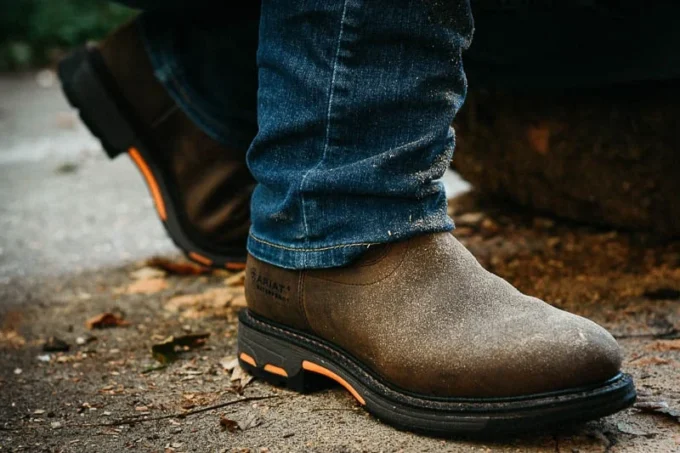Hitting the trail can be a good way to de-stress after a long day of work or simply serve as a perfect outdoor holiday for those of us who love spending time in nature. However, if you are going hiking after wrapping up at work, you may not have the time to go home, change boots, and then make your way to a trailhead.
Some people either don’t have the space to store two separate pairs of boots in their home or simply want to avoid the additional cost if possible. If either of these sounds like you, you may wonder whether a new pair of hiking boots is really necessary – can you get away with using your work boots for hiking?
If you’re seriously considering this question, you’re in the right place. Here’s all you need to know about wearing your work boots while hitting the trails.
Work Boots vs. Hiking Boots
The first question you need to ask is the most basic one – do work boots and hiking boots actually differ?
The simple answer is yes. While the two may look similar at first glance, there are some specific ways in which standard work boots differ from hiking boots. These include:
- Hiking boots are designed to help you trek through uneven ground, and their design reflects this. They generally feature an uneven pattern of lug soles to ensure you get the most traction possible, which is particularly helpful when hiking on rocky surfaces or climbing boulders. While work boots feature a lot of traction as well, they’re definitely not as effective as dedicated hiking boots.
- Work boots have great protection around the toe and the top of the foot while hiking boots are designed to withstand water. Both types of boots are durable, but the type of durability varies depending on what they’re designed for.
- Work boots, especially steel-toed boots, are pretty heavy. This gives you additional protection but can be an issue when you’re hiking.
- Hiking boots are generally made with EVA foam insoles, which are light and flexible. On the other hand, work boots most commonly feature thick, stiff rubber soles to give the bottom of your feet the most protection possible. They may also contain steel shanks, which again, increase protection, but at the cost of flexibility.
- Work boots generally lack the type of ankle support that hiking boots offer, which may increase the risk of sprains and twists when wearing them while hiking.
That said, these differences don’t necessarily mean that you cannot use your work boots for hiking.
Using Work Boots When Hiking

Source: unsplash.com
It is possible to use your work boots when hiking – as long as you’re careful.
The first thing to keep in mind is that you should choose the right work boots. Ideally, this means choosing work boots that are designed for the geographical location you plan on hiking.
For example, if you’re hiking in Australia, you should buy Australian-made work boots – these are frequently designed to address outdoor challenges you might come across when hiking there. If you’re planning to go hiking in Australia, you can click here to view some reliable Australian work boots. Similarly, if you’re planning to go hiking in California, buy Californian-made work boots.
Additionally, make sure you’re not using your work boots for a complex hike. As mentioned above, work and hiking boots have differences, and this can make using work boots on extremely rocky, or otherwise challenging terrain, risky. However, they function pretty well if you’re going for a short hike that lasts for a couple of hours.
You shouldn’t depend on your work boots if you go hiking often. If you’re the type of person that goes on a short hike once or twice a year, you’ll be fine without dedicated hiking boots. However, if you’re planning a week-long trip or go hiking every weekend, you should definitely pick up a pair of hiking boots – the added comfort and safety features are well worth the investment.
Using Hiking Boots at Work
Just as you might think that using your work boots for hiking is a good way to save money and space, you might wonder if the reverse is a good idea – after all, if, as an avid hiker, you need hiking boots, why not use them for work as well?
Similar to what we discussed above, hiking boots can be used for work – in certain situations. Hiking boots are designed to function well outside, so they’re generally waterproof, and they also offer added foot support. Furthermore, the design of the soles offers greater traction than most work shoes, and while they’re flexible, they’re generally still stiff enough to do the job on a work site.
The biggest challenge that hiking boots offer on worksites is protection. As mentioned above, work boots often have steel toes and better protection around the top of the foot. This means if you drop something on your feet or accidentally bump into heavy equipment, you won’t feel the impact. The thicker soles also mean you can walk over a ton of debris without worrying about injury.

Source: bootspy.com
So, the answer to whether you can wear hiking boots to work depends on the nature of your work and worksite. If you anticipate being around heavy objects that might accidentally fall or walking over floors with tons of debris, it’s best to opt for dedicated work boots designed to protect your feet. However, if this isn’t something you need to worry about, you’ll probably be okay wearing your hiking boots to your job.
Additionally, keep in mind that some job sites have specific safety requirements for everyone working there. This may include wearing a particular type of boots or boots that meet certain safety standards. Before you make the switch from work boots to hiking boots at your job, make sure to check you’re not breaking any rules or regulations.
Your work boots can function as a pair of hiking boots in a pinch, and they’re a good option for the occasional hiker. However, if you do go hiking pretty often, it’s always best to invest in a dedicated pair of boots for the job.







